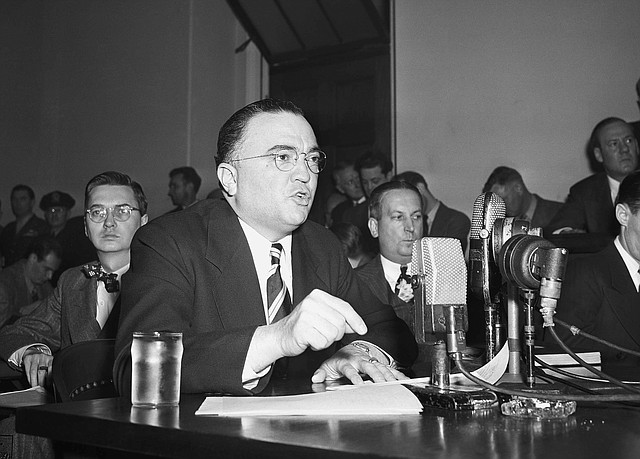Civilians trained for '50s Soviet invasion
This March 26, 1947, fi le photo shows Federal Bureau of Investigation Director J. Edgar Hoover calling the Communist Party of the United States a “Fifth Column” whose “goal is the overthrow of our government” during testimony before the House Un-American Activities Committee in Washington
Monday, September 1, 2014
WASHINGTON -- Fearing a Russian invasion and occupation of Alaska, the U.S. government in the early Cold War years recruited and trained fishermen, bush pilots, trappers and other private citizens across Alaska for a covert network to feed wartime intelligence to the military, newly declassified Air Force and FBI documents show.
Invasion of Alaska? Yes. It seemed like a real possibility in 1950.
"The military believes that it would be an airborne invasion involving bombing and the dropping of paratroopers," one FBI memo said. The most likely targets were thought to be Nome, Fairbanks, Anchorage and Seward.
So FBI director J. Edgar Hoover teamed up on a highly classified project, code-named Washtub, with the newly created Air Force Office of Special Investigations, headed by Hoover protege and former FBI official Joseph Carroll.
The secret plan was to have citizen-agents in key locations in Alaska ready to hide from the invaders of what was then only a U.S. territory. The citizen-agents would find their way to survival caches of food, cold-weather gear, message-coding material and radios. In hiding they would transmit word of enemy movements.
This was not civil defense of the sort that became common later in the Cold War as Americans built their own bomb shelters. This was an extraordinary enlistment of civilians as intelligence operatives on U.S. soil.
This account of the Washtub project is based on hundreds of pages of formerly secret documents. The heavily censored records were provided by the Government Attic, a website that publishes government documents it obtains through the Freedom of Information Act.
The Russians never invaded, of course.
With the benefit of hindsight, it would be easy to dismiss Washtub as a harebrained scheme born of paranoia. In fact, it reflected genuine worry about Soviet intentions and a sense of U.S. vulnerability in a turbulent post-World War II period.
As the plan was being shaped in 1950, Soviet-backed North Korea invaded South Korea, triggering a war on the peninsula that some in the Pentagon saw as a deliberate move by Moscow to distract Washington before invading Europe. The previous summer the Soviets stunned the world by exploding their first atomic bomb. Also in 1949, the U.S. locked arms with Western Europe to form the NATO alliance, and Mao Zedong's revolutionaries declared victory in China, adding to American fear that communism was on the march.
Washtub had two phases.
The first and more urgent was the stay-behind agent program. The second was a parallel effort to create a standby pool of civilian operatives in Alaska trained to clandestinely arrange for the evacuation of downed military air crews in danger of being captured by Soviet forces. This "evasion and escape" plan was coordinated with the CIA.
The agents also got extensive training in coding and decoding messages, but this apparently did not always go well. Learning these techniques was "an almost impossible task for backwoodsmen to master in 15 hours of training," one document said. Details in the document were blacked out.
Many agent names in the Special Investigations and FBI documents also were removed before being declassified.
Recruiters pitched patriotism and were to offer retainer fees of up to $3,000 per year (nearly $30,000 in 2014 dollars). That sum was to be doubled "after an invasion has commenced," according to one planning document. The records do not say how much was actually paid during the course of the program.
At least some recruits were fingerprinted and all were secretly screened by the FBI for signs of disloyalty.
One was described in a May 1952 Special Investigations memo to the FBI office in Anchorage as the postmaster in Kiana, Alaska, another was manager of a hotel in Valdez. One agent candidate worked for a tin-mining company at Lost River on the Seward Peninsula, one of the higher-priority areas for placing Washtub stay-behind agents.
Washtub was crafted in painstaking detail. But just as the first trained agents were to be put in place in September 1951, Hoover pulled out, leaving it in Special Investigations' hands.
Hoover worried that when the shooting in Alaska started, the FBI would be "left holding the bag."
"If a crisis arose we would be in the midst of another 'Pearl Harbor' and get part of the blame," Hoover wrote in the margin of a Sept. 6, 1951, memo from an aide, to whom Hoover added one final order: "Get out at once."
A Section on 09/01/2014
